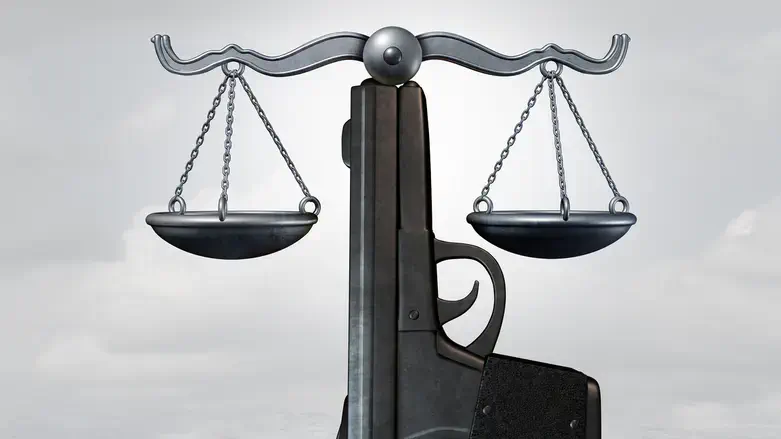
Part I
The Israeli security establishment provides that anyone in a security branch, IDF, Mossad, etc., is able to reach out to the head of their respective branch to communicate vital information they believe is not being relayed through the formal chain of command.
There is no arrangement, hard as it is to believe, for someone in a security branch to relay such vital information to the Prime Minister or the Minister of Defense if the head of their respective security branch opts not to share this information.
Recent developments (see here) have demonstrated that this is not a theoretical problem and that to some it is not obvious that the Prime Minister is entitled to know and see every piece of information extant.
The following is the wording of a proposed law to address this critical flaw:
Critical Security Information Reporting Law to the Political Echelon, 2024
1. Purpose:
This law is designed to allow any individual within the security establishment to report critical information directly to the political echelon in exceptional cases where there is a well-founded concern that the information has not been transmitted for non-objective reasons. The law ensures the reporting individual's right to act, while preserving the security system's ability to assess the impact of the action on their career within the system.
2. Definitions:
1. Critical Information: Information of significant importance to national security or human life, where failure to transmit such information could cause serious harm.
2. Political Echelon: The Prime Minister, Minister of Defense, or their designated representatives.
3. Reporter: Any soldier, officer, or employee of the security establishment who holds critical information and believes it has not been properly conveyed to the political echelon.
3. Right to Report:
1. Any reporter has the right to directly transmit critical information to the political echelon if the following conditions are met:
- . The information pertains to an immediate threat or a strategically significant matter.
- . The reporter has attempted to transmit the information through the chain of command but was unsuccessful, or there is a well-founded concern that the information has been withheld for non-objective reasons.
4. Reporting Procedure:
1. The reporter must provide written notice to their immediate superior or another appropriate senior official of their intention to transmit the information to the political echelon.
2. The reporter must act with full transparency within the system and provide a copy of the information to their superior.
5. Consequences of Reporting:
1. Responsibility of the Reporter:
- . The reporter will bear full responsibility for the accuracy and implications of the information reported.
- . The system retains the right to consider the impact of the reporting on the reporter's career or advancement within the organization.
2. Limited Protection:
- . The reporter will not automatically be protected from internal organizational consequences (such as impact on career progression) but will be immune from criminal or administrative penalties.
3. Confidentiality:
. The information will remain confidential and will only be transmitted to the authorized political echelon.
6. Applicability:
This law applies to all security and intelligence units, including the IDF, Shin Bet, and Mossad.
7. Regulations:
The Minister of Defense, in coordination with the Chief of Staff, is authorized to establish regulations for the implementation of this law, including defining reporting procedures and information transfer protocols.
Summary:
This law enables reporters to transmit critical information directly to the political echelon in exceptional cases but does not provide immunity from internal organizational consequences. It maintains the balance between the right to report and the system's authority to manage the implications on the reporter's career.
________________________________________
Part II
Since there seems to be a real tragi-comedy of the absurd playing the the Shabak theater, it does not seem so far-fetched to imagine this scenario, a parody of what negotiations with Hezbollah might achieve:
It would be patently absurd for the international inspection company, SGS, to catalog and label all the weapons Hezbollah has at the moment of a ceasefire and then serve as an intermediary when Israel claims Hezbollah has added weapons to their inventory.
U.S. envoy Amos Hochstein is working on an equally absurd proposal.
Correction: a WORSE proposal.
Why worse?
Because, beyond allowing Hezbollah to keep all their weapons, U.S. envoy Amos Hochstein is proposing that we enter into negotiations for "border adjustments".
That's right.
The Biden administration thinks it would be a swell idea to reward Hezbollah with Israeli territory.
Can you imagine this as the next step?
[PARODY] Protocol for Inspection and Oversight of Hezbollah Weapons Inventory under Ceasefire Agreement
Objective
This protocol establishes a framework for inventorying, monitoring, and overseeing Hezbollah’s arsenal of rockets, missiles, drones, and related weaponry during a ceasefire. It aims to ensure compliance with the ceasefire terms while respecting Lebanon’s sovereignty and minimizing civilian harm.
Section I: Initial Inventory and Identification by Société Générale de Surveillance (SGS)
1. Inventory Procedure
• SGS will conduct a comprehensive inventory of all rockets, missiles, drones, and other weaponry in Hezbollah’s possession.
• Hezbollah will grant SGS unrestricted access to its storage facilities and weapons caches under strict confidentiality to ensure transparency.
2. Identification and Tagging
• SGS will apply tamper-proof stickers or markers to each weapon and is free to decorate them. These stickers will:
• Be uniquely numbered to correspond with the weapon.
• Include security features to prevent counterfeiting.
• Be durable and resistant to environmental damage.
• Each weapon will be photographed and cataloged alongside its unique number in a secure, centralized database maintained by SGS.
3. Reporting and Documentation
• SGS will produce an inventory report listing all weapons, their unique identifiers, and storage locations. This report will be shared confidentially with the ceasefire stakeholders: Hezbollah, Israel, and the designated ceasefire monitoring body (e.g., UN representatives).
Section II: Handling Claims of Additional Weapons
1. Submission of Evidence
• If Israel identifies suspected new weapons not included in the initial inventory, it will submit evidence to SGS. Evidence must include:
• Location coordinates.
• Supporting data from satellite imagery, reconnaissance, or other verifiable sources.
2. Unannounced Inspections
• SGS will dispatch inspectors without prior warning to the specified locations to verify the claim.
• Inspectors will document their findings, including photographing the weapons and checking for the absence of inventory stickers.
3. Resolution of Violations
• If SGS confirms the presence of new, undocumented weapons:
• Hezbollah will be given the opportunity to destroy the weapons under SGS supervision.
• If Hezbollah refuses, Israel will have the right to neutralize the weapons.
• Israel’s actions must comply with proportionality requirements outlined in international humanitarian law:
• Civilian casualties must be minimized.
• If weapons are in a civilian-populated area, Israel must use precision methods or seek alternative solutions to avoid significant harm to non-combatants.
Section III: Replacement of Defective Weapons
1. Procedure for Replacement
• Hezbollah may replace defective weapons with functional ones under SGS supervision.
• SGS will:
- Verify the defectiveness of the weapon being replaced.
- Assign a unique sticker to the new weapon and update the inventory database.
2. Transparency and Accountability
• All replacements will be documented in a supplemental report by SGS and shared with ceasefire stakeholders to ensure transparency.
Section IV: Provisions for Unilateral Destruction of Inventory Weapons by Israel
1. Documentation of Destruction
• In the event that Israel conducts a unilateral attack against Hezbollah, causing damage or destruction to weapons included in the official inventory, SGS will verify and document the losses.
• The verification process will involve:
-Inspecting the destroyed sites.
- Comparing the destroyed weapons to the inventory database using their unique identifiers.
2. Replacement of Destroyed Weapons
• Hezbollah will have the right to replace weapons destroyed in unilateral Israeli attacks, subject to the following conditions:
- Replacements must be of the same type and quantity as the destroyed weapons.
- The replacement process will be conducted under SGS supervision to ensure transparency.
- The new weapons will be assigned unique stickers and updated in the inventory database.
3. Reporting
• SGS will provide a detailed report on the destruction and replacement process to all ceasefire stakeholders to ensure accountability.
Section V: Israel’s Monitoring Restrictions
1. Respect for Sovereignty
• Israel will not conduct monitoring activities that violate Lebanon’s territorial integrity.
• Monitoring will rely on:
- Satellite imagery.
- Reconnaissance conducted from beyond Lebanese airspace or territorial waters.
2. Monitoring Distance
• A minimum distance of:
- 20 km offshore from Lebanese territorial waters for maritimesurveillance.
- 5 km from the Lebanon-Israel border for land-based monitoring, ensuring no violation of airspace.
3. Altitude Considerations
• Israel will utilize high-altitude surveillance methods that do not infringe upon Lebanese airspace sovereignty. While there is no universally agreed-upon vertical boundary between national airspace and outer space, the Kármán line at 100 km altitude is commonly used as a reference point. Israel will ensure that any aerial surveillance platforms operate at altitudes above 100 km to avoid violating Lebanese airspace.
4. Reporting Mechanisms
• Israel will submit findings to SGS for verification rather than act unilaterally, ensuring all claims are addressed through the protocol.
Section VI: Oversight and Compliance
1. Ceasefire Monitoring Body
• A neutral monitoring body (e.g., the United Nations) will oversee the implementation of this protocol and address disputes.
2. Regular Audits
• SGS will conduct periodic audits of Hezbollah’s weapon inventory to ensure compliance.
• Any discrepancies will be reported immediately to all stakeholders.
3. Accountability Measures
• Violations of the protocol by either party will be referred to the ceasefire monitoring body for resolution and potential sanctions.
Section VII: Conclusion
This protocol balances the need for accountability with the respect for sovereignty and international law. By leveraging the expertise of SGS and implementing clear procedures, it ensures that all parties adhere to the ceasefire terms while minimizing risks to civilians and maintaining regional stability.
Remember: Insanity is repeating the same thing over and over and expecting different results.
________________________________________
Dr. Aaron Lerner heads IMRA - Independent Media Review and Analysis, since 1992 providing news and analysis on the Middle East with a focus on Arab-Israeli relations Website: www.imra.org.il
